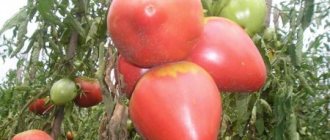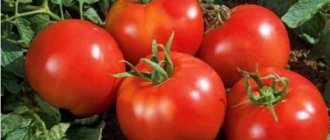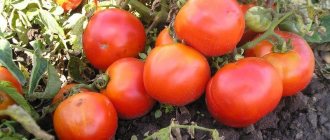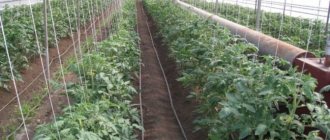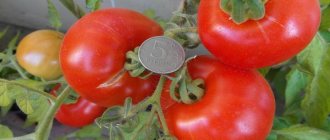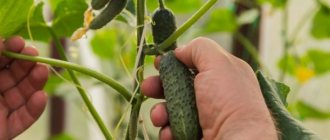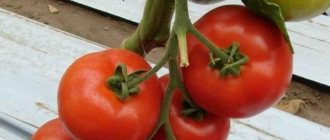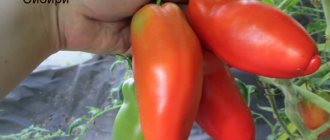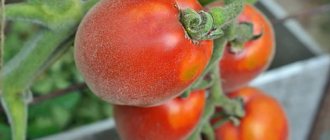Tomatoes of the “Hummingbird” variety are perfect for pickling and marinating. They have an attractive and small shape and look nice in a jar. The elastic skin protects the tomato from cracks and prevents juice from leaking out. The tomatoes taste sweet and juicy.
Tomatoes of the “Hummingbird” variety contain a balanced composition of vitamins and other nutrients. Their consumption has a positive effect on the functioning of the heart, liver, and kidneys. Tomatoes activate the body’s protective function, making it less susceptible to diseases.
Description of the variety
The Kolibri tomato variety is a first generation hybrid. This is indicated by the designation f1.
The hummingbird was bred by French breeders. The variety belongs to heat-loving crops. Designed for growing in greenhouses and greenhouses.
It is characterized by persistent immunity to many diseases and rare late blight.
Tomato seeds are relatively inexpensive. The variety gives a bountiful harvest. During the season you can harvest an excellent harvest with minimal costs for planting material and chemicals.
Photo of the hybrid:
Characteristics
Tomatoes of the Kolibri variety produce large oblong fruits weighing up to 160 g. Tomatoes have a balanced composition and sweet and sour taste.
Thanks to the large number of fruits on one cluster, more than 10 kg of harvest can be obtained from one Hummingbird bush. Tomatoes are harvested before the first frost.
Kolibri tomatoes are meaty. Inside there are 4-5 chambers with seeds, which, due to the hybridity of the variety, are not suitable for cultivation. The color of the tomato skin and pulp is red.
The fruits are suitable for canning and fresh consumption. Therefore, the variety can be considered universal.
Characteristics of Hummingbird
The characteristics of the Hummingbird variety will impress the most experienced gardener.
Description of Hummingbird tomatoes:
| Parameter | Indicators |
| Bush type | Indeterminate. Bush with constant growth. It can grow up to 2 m high. The stems and leaf blades are powerful. They have a dark green tint. The root system is developed. |
| Growing method | Belongs to heat-loving, heat-resistant varieties. Recommended for growing in greenhouses (both heated and unheated). |
| Productivity | The variety is high-yielding. Up to 10 fruits grow on one cluster. From 1 sq. m harvest 10-15 kg of tomatoes. |
| Fruit | Bright red inside and out. They have an oblong oval shape. The tomatoes are juicy, dense, fleshy and thick-walled. They have a rich aroma. They have a sweet and sour taste. There are no green veins inside, and green spots outside. |
| Transportability | Good. Tomatoes have thick skin. They can be stored without losing their shape for a month. |
| Ripening time | Early ripening. The ripening period is 95 days. Refers to all-season varieties. |
| Disease resistance | Resistant to verticillium and fusarium wilt, tomato mosaic and nematode. Rarely affected by late blight. |
Growing seedlings
Planting and caring for seedlings is an important point in growing tomatoes. Further results depend on the quality implementation of this task.
Seeds are sown either at the end of February or at the beginning of March. The time for planting is chosen according to the lunar calendar.
Seed preparation
To successfully grow tomatoes, planting material is sorted. It is important to get rid of damaged and coated seeds.
Seed preparation:
- Hummingbird seeds are pre-treated by soaking in a light pink solution of potassium permanganate. If it is not there, use a soda solution.
- The floating seeds are removed. They won't germinate.
- The material is treated with a growth stimulator. To do this, they are placed in the solution overnight. Instead, you can wrap the seeds in wet gauze, which is constantly moistened until germination.
This is interesting! Before sowing the seeds, make sure they are fresh. Expired ones have low germination rates.
Selection of container and soil
You can buy a container for planting seedlings in a specialized store or make it yourself. Sizes vary depending on the stage of tomato cultivation.
First, the seeds are sown in a large container: in polymer trays, wooden boxes or special cassettes.
After germination, they are transplanted into individual containers: plastic or peat pots, or special tablets.
Advice! If there are no special containers for seedlings, it is not necessary to buy them. Can be made from mayonnaise jars, cut-off bottles, disposable plastic or cardboard coffee cups.
You can prepare the soil yourself or buy it at a specialty store. Purchased soil has a balanced composition with all the necessary elements.
To independently prepare the soil for growing seedlings, you need to mix peat with turf and humus in a 2:1:1 ratio. To enrich, add a little ash and superphosphate.
Advice! Both purchased and self-prepared mixtures are disinfected. To do this, the soil is either watered with a weak solution of potassium permanganate, or calcined at a temperature of 80 ° C and above.
Sowing seeds
So:
- Tomato seeds are buried 1 cm into the ground. Leave a distance of at least 0.5 cm between the seeds.
- The earth is moistened with water at room temperature.
- The container is covered with film on top and placed on the windowsill. The room temperature should not fall below 25° C.
- It is important to regularly ventilate the seedlings. This will help avoid moisture stagnation and mold development. In warm weather, the film is opened daily for several hours.
The main points of growing Hummingbird tomato seedlings
Powerful and healthy seedlings will take root better when transplanted into the ground.
Several rules will help you get this result. Rules for growing seedlings:
- Water the seedlings as the soil dries with a spray bottle. Plants should not be flooded or allowed to dry out.
- It is important to maintain not only the humidity level in the room, but also the optimal temperature.
- After the leaves appear, the seedlings are planted in individual containers.
- 10 days after transplantation, feed with complex fertilizers.
- Before planting in the ground, the seedlings are hardened: two weeks before transplanting, they are taken out to the balcony or outside for several hours in the warm season.
Landing
The soil for transplanting future seedlings is prepared in the fall, and the seedlings are sown in March. Land preparation:
- digging the soil to a depth of about 30 cm;
- cleaning up last year's tops and weeds;
- in the greenhouse - replacement of the top layer of soil and disinfection (prepare a hot solution of copper sulfate or potassium permanganate, which is poured onto the ground);
- application of fertilizers (for example, a bucket of compost for each square meter or mineral fertilizers according to the instructions).
For tomatoes, do not choose beds after other nightshades: eggplants, tomatoes, peppers, potatoes. It is better to place seedlings in sunny beds after cucumbers, onions, legumes, and carrots.
To plant seedlings, prepare a nutrient substrate, which contains soil from the garden, a little peat and humus, and sand. Add 1-2 cups of wood ash and a couple of teaspoons of mineral fertilizer to a bucket of soil: nitrate, superphosphate. The mixture is disinfected by keeping the composition in the oven for about an hour at a temperature of +110. Spill with a hot solution of potassium permanganate.
The seeds are not processed as the hybrid seed undergoes proper processing before packaging. Growing seedlings:
- Make furrows 1-2 cm deep in the soil, leaving about 3 centimeters between rows.
- Sow the seeds, pour a thin layer of soil on top, and spray with water from a spray bottle.
- Cover with film or glass.
- Keep in a warm place for several days, until more than half of the shoots appear.
- Open the container and reduce the temperature to +16 for three days.
- After three days, set the temperature to +18-22.
- Keep the boxes on the windowsill, periodically turning the other side towards the sun. Daylight hours are at least 12 hours.
- Feed the seedlings 1-2 times with a weak solution of mineral fertilizer or a preparation for seedlings.
- 10-14 days before planting in a permanent place, the bushes are hardened off, taking them outside every day.
- After 55-60 days, the seedlings are ready for transplanting.
The recommended planting pattern is 70 by 50 cm.
Growing tomatoes
Tomato Kolibri is a greenhouse variety. In a greenhouse, you can get the most abundant harvest. At the same time, the plants are resistant to heat and frost.
Hummingbirds are easy to care for, rarely get sick, and have good yields even in the absence of regular feeding. A novice gardener can easily cope with growing a hybrid.
Planting seedlings in the ground
The seedlings are transplanted into an unheated greenhouse two months after the seeds germinate. Planting takes place in the middle or end of May. By this time, the morning frosts have already subsided.
Compost and ash are added to the soil for planting tomatoes. Undiluted manure should not be added; such fertilizer will lead to the death of tomatoes.
Plants are buried down to the cotyledon leaves. This creates a powerful root system.
Planted according to the 70X50 pattern. Placing tomatoes too close will reduce the yield and increase the risk of pests and diseases.
The first watering is five days after transplanting the tomatoes into the greenhouse. Before this, you need to loosen the ground around the bushes.
Nuances of care
Watering is an important point in plant care. Performed in the morning once a week. In hot weather, the number of weekly waterings is increased to 3 times and the soil is regularly loosened. This will ensure air flow to the roots.
The manufacturer recommends forming Kolibri into two stems - this increases the yield.
New shoots on bushes must be removed. You also need to deal with the leaves at the bottom of the plant, yellowed and wilted greenery.
Stepping is done in the morning. On the day of the procedure, the plant is not watered.
The Hummingbird tomato is a crop with constant growth, and therefore requires obligatory garter.
Growth stimulants improve the quality of bushes and accelerate the formation of ovaries. For these purposes, nitrogen, phosphorus and potassium fertilizers are used once every 2 weeks.
A solution of boric acid is a foliar feeding that will accelerate the appearance of fruits. Complex fertilizers can also be used for tomatoes.
Growing Tips
Experienced gardeners give effective advice:
- Carefully weed the weeds around the bushes. They can lead to the death of cultivated plants.
- Use gloves when picking tomatoes. The juice of this plant can cause an allergic reaction if it comes into contact with the skin.
- Once a week you can spray the leaves of the plant with water. More often it is impossible to avoid infection with late blight.
Disease and pest control
The Kolibri tomato is resistant to most existing diseases, which makes it easier to care for and reduces the need for chemical treatment.
Despite the fact that the hybrid is resistant to many plant diseases, it is often attacked by insects. Therefore, it is necessary to take measures in advance to combat pests.
The first step in insect control is to remove all weeds to avoid attack by mole crickets and slugs.
Aphids love tomato greens. Timely treatment of the bushes with a weak soap solution will save you from it.
To prevent the plant from getting late blight, monitor the humidity level in the greenhouse, preventing it from increasing. To do this, carry out regular ventilation.
Pros and cons of the plant
The plant has more positive qualities than negative ones. The bred breed has recently been able to gain trust, reviews and popularity among many gardeners. The advantages of the plant are:
- Indeterminateness;
- High yield;
- The plant has a good immune system and is resistant to many viruses and diseases;
- The tomato does not require frequent care;
- The fruits are fleshy and characterized by good keeping quality and are easy to transport;
- Vegetables do not crack when preserved;
- The tomato is adapted to different growing zones;
- The variety has early ripening periods.
The downside of the plant is that it needs to be tied up and pinched. Also, the crop is a hybrid, so you cannot get the seeds yourself. But thanks to a good harvest, the crop is worth it.
Harvest and use
In mid-summer, the first ripe fruits appear on the Hummingbird bushes. Tomatoes are harvested by hand, leaving the stem, which will help them last longer and ripen faster.
It is important to pick ripe tomatoes in a timely manner to prevent late blight from damaging unripe fruits.
Green fruits ripen when picked. After two weeks, it is difficult to distinguish them from tomatoes that have ripened in the garden.
Kolibri tomatoes have a sweet and sour taste. According to reviews from gardeners, they are ideally suited for conservation.
Tomato varieties for pickling and canning
Tomatoes have gone through a long and very unusual journey before they came to our table. The Aztecs began growing them as a garden crop. Europeans discovered this plant in the 16th century, but considered it ornamental and grew it in gardens. It never occurred to them to taste their fruits.
Interesting historical fact
Few people would have dared to try tomato fruits at that time, since there was a rumor that they were poisonous. But still, a daredevil was found. It turned out to be Robert Gibbon Johnson, an American colonel, and also a famous farmer and plant grower.
He wanted to dispel the myth about the harmful effects of tomatoes on the body. To rid the people of America once and for all of a common misconception, Colonel Johnson defiantly ate an entire basket of tomatoes in 1820.
Farmers' reviews about the variety
Tomato Hummingbird mainly enjoys positive reviews from experienced and novice gardeners.
Farmer reviews about tomato:
Martynenko Karina, Moscow: “Hummingbird is my favorite variety. I am reaping a bountiful harvest. From 1 sq. meter produces at least 10 kg of tomatoes. I use them for winter preparations and for salads.”
Turner Andrey, Voronezh: “I plant hummingbirds to store them for the winter. Pickled tomatoes do not crack and have a lot of pulp. Really easy to care for and produce a lot of fruit. In my opinion, it’s too sour for salads; I like pink varieties fresh.”
Advantages and disadvantages
The “Hummingbird” variety is popular and has many positive qualities. This:
- Hard peel and juicy sweet flesh.
- Early ripening.
- High yield.
- Immunity to tomato diseases.
- Tomatoes' unpretentiousness when choosing soil.
- Possibility of planting in open ground.
Tomatoes of this variety are often used not only in preparations; they can be cut into salads. The tomato slices hold their shape perfectly and do not fall apart.
Possible diseases and pests
Difficulties with growing the Hummingbird variety of cucumbers arise quite rarely. Usually the cause of problems is non-compliance with agricultural technology and general rules for growing crops. In this case, both dangerous fungi and all kinds of insect pests may appear in the beds.
The most common infectious diseases of the Hummingbird variety:
| Name | Fighting methods |
| Anthracnose | Sick bushes are sprayed with solutions of copper oxychloride (4 g / 1 l of water), and treatments are carried out every 10–12 days until the infection is completely eliminated. |
| Bacteriosis | The pathology can be overcome by spraying with copper oxychloride (4 g/l of water), with an interval of 10 days, until complete recovery. |
| Downy mildew | Plants are treated twice with highly active fungicidal preparations (Acrobat MC, Ridomil MC, Kurzat R) with an interval of 14 days. |
| Sulfur and white rot | Plantings are sprayed with urea solution (1 g / 1 l). It is applied to the beds once a week until the manifestations of rot are completely eliminated. |
Typical crop pests:
| Parasite name | Remedies |
| Thrips | The plantings are treated with the preparations “Aktellik”, “Confidor”, “Karate” |
| Ticks | They fight the pest by spraying with Actellik or Talstar. |
| Aphid | Treatment of plants with Confidora or Karate solution will help eliminate the pest. |
| Bedbugs | Affected plantings are treated with the insecticide “Karate” or “Confidor” |
Description and characteristics of the hybrid
Description of the Main Caliber f1 tomato should begin with the fact that this variety belongs to the determinant type. The hybrid was bred for cultivation in open ground, as well as in greenhouses or film shelters.
Determinate tomato bushes are usually limited in growth - on the central shoot in the upper part, instead of a tip with foliage, an ovary with buds is formed, and the shoot does not grow further. Subsequently, one can expect further development of the plant from the lateral stepsons in the lower leaf axils. To obtain a full harvest, bushes of such tomatoes are formed into 2-3 trunks. Typically, breeders create determinate hybrids specifically for growing in greenhouses, since their height does not exceed 1.5 m, and the bushes are quite compact, which allows more tomato bushes to be planted in protected ground.
The characteristics of this tomato are strong, powerful bushes of medium height (about 1.5 m). The shoots are strong, well leafy, the foliage is of medium size, typically tomato, dark green in color.
Usually, after the first or second true leaf, an ovary is formed. Up to 5-6 inflorescences can form on one shoot. This hybrid requires formation into one stem. But if the plant is grown in a greenhouse, or in warm areas in open ground, in order to obtain harvests throughout the season, you can leave lateral shoots after harvesting the first ripe tomatoes. New ovaries will form on them in the future.
The ripe fruits of the Main Caliber are round in shape, fleshy, the pulp is sugary, fine-grained. The skin is smooth and quite dense. The color of ripe tomatoes is deep crimson. Although some summer residents note that the color of the ripe fruits of this tomato can be bright scarlet. You don’t even need to cut ripe tomatoes – they break easily with your hands.
OLYMPUS DIGITAL CAMERA
A ripe tomato can reach a weight of 0.5 to 1.5-2.0 kg. With timely fertilizing, you can harvest fruits weighing more than 2 kg. The yield of the variety is quite high - up to 5-7 kg per bush; in greenhouse conditions, higher yields can be harvested.
Main Caliber is intended for fresh consumption. The fruits can also be used to prepare tomato puree and tomato juice.
